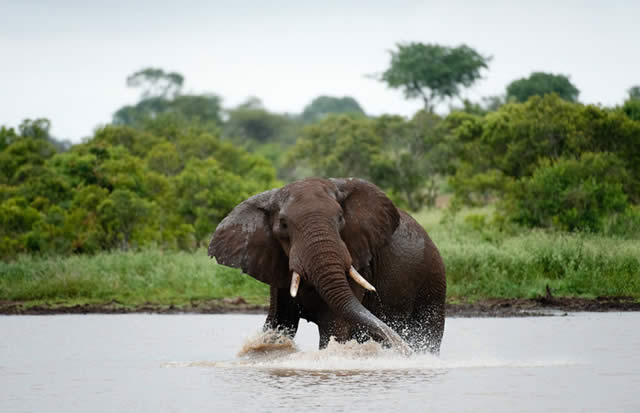Fresh water availability biggest threat to elephants


The biggest concern for elephants is their need for large amounts of fresh water, and the influence this has on their daily activities, reproduction and migration
Jeffrey Gogo Climate Story
THE African elephant is better positioned to adapt to climate change and variability, but its greatest future threat will come from neither poaching nor food scarcity; it’s fresh water availability to cause headaches, a new study has found. Elephants are a playful lot, huge as they are, and water is not only central to drinking, but also play and a kind of bathing; bathing in the mud, and sometimes water proper.
In a day, an adult 6-tonne elephant uses between 150 and 300 litres of water, 15 times as much as Africa’s per capita consumption, or the equivalent of 120 000 drums of 200-litre capacity each, in Zimbabwe’s case, home to an herd of 80 000.
“. . .the biggest concern for elephants is their need for large amounts of fresh water, and the influence this has on their daily activities, reproduction and migration,” said the World Wildlife Fund (WWF), global conservation body, in a report released last week, African Elephant and Climate Change.
The WWF considers the elephant’s vulnerability to water scarcity as “high.” Vulnerability measures the extent to which humans, animals or geophysical features can or cannot cope with climate change.
A vulnerability reading of “high” means the ability to cope is low. Now, within the elephant nation, water defines life in more ways than one.
“Droughts can effect populations immediately by increasing mortality or reducing conception rates,” said the WWF, noting also that there is strength in numbers — the 500 000 total African herd has been key to building climate resilience.
To reproduce at the highest level, elephants will need rainfall to be at its highest. Weird, isn’t it? Others require just a single fertile male seed. Not really. “Reproduction is tied to rainfall,” the report explained.
“Birth peaks coincide with rainfall peaks. Drought inhibits conception through impacts on vegetation that subsequently affect the female’s ability to come into breeding condition.”
Climate change threatens to disrupt (or already is) this order of the natural. The UN’s expert panel on climate change was high on confidence rainfall will decline in southern Africa and that hot days and droughts will frequent by mid century, according to its Fifth Assessment Report last year.
Another World Bank report in 2012 predicted that in a 4 degrees Celsius warmer world, towards which the world is gravitating, evaporation in lakes, rivers, dams and streams across southern Africa will reach 50 percent by 2080, causing widespread freshwater shortages.
In conducting the study, the WWF determined vulnerability using the factors of sensitivity, adaptative capacity, exposure and other threats.
The Fund assessed issues such as “the inability of the species to persist, as is, under changing climatic conditions and the ability of the species to respond to changes in climate.”
It also examined the extent of current and future impacts of climate change on elephants “and any other relevant threats, as well as the human responses to climate change that exacerbate these threats.”
Not Good Enough
If temperature rise comes in at the projected WB margins, chances that elephants will become susceptible to diseases such as anthrax, foot and mouth, and rinderpest is “medium,” a rung below danger, but not safe, as elephants are heat intolerant, a major drive for the mud baths.
However, the female’s ability to deliver up to 7 offsprings in a lifetime that stretches to 60 years, and the elephant’s ability to disperse over long distances in one day, are important adaptative characteristics. Both are “medium” rated, says the WWF.
But that’s not good enough, as habitat continues to shrink.
“An increasingly limited dispersal ability due to habitat fragmentation, coupled with a long generation time and moderate amounts of genetic variation, may limit the ability of the species to adapt to a changing climate,” the report said.
Food isn’t much of an issue. Elephants can eat anything from grass, leaves, fruits, bark and roots. The WWF says there are over 170 plant species that the largest land mammal could feed on.
And that the animal can be found in 37 African countries, with different climates and different habitats, means the elephant has been “exposed to broad climate variability,” aiding their chances at surviving in harsher climate change-induced conditions.
What To Do
Poaching and conflicts with humans over habitat, water and food remain in the “high” category, with real potential to weaken the capacity to adapt, but not as much freshwater shortage.
Tackling these future risks calls on governments to dig deeper into their own pockets, and those of global funders, creating systems that deliver specific resilience goals for humans, livestock and wildlife.
“Priorities for climate-informed African elephant conservation should include securing fresh water; maintaining and increasing suitable, connected habitat; and increasing the monitoring for disease and other causes of mortality,” said the WWF.
“It is also essential to create improved conditions for people to adapt to current and future changes in climate, and to continue to reduce threats such as poaching.”
Elephants are a strategic resource to Zimbabwe, economically and ecologically, but conservation has come under serious threat from high incidents of sophisticated poaching, and funding challenges at Government level.
As a result, Government has resolved to offload some of its excess herd —numbered at 40 000 — to willing and capable foreign buyers, a decision that has drawn the ire of many a conservationist.
Despite the furore, the WWF, however, regards Zimbabwe a pioneer in elephant conservation. The Fund says on its website: “Zimbabwe is globally renowned for its past visionary approach to natural resource management.
“It was the first African country to develop a noticeable alternative approach to the management of natural resources outside protected areas in 1975.”
Happy 35th independence anniversary.
God is faithful.










Comments